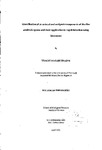IDENTIFICATION OF STRUCTURAL AND ANTIGENIC COMPONENTS OF BACILLUS ANTHRACIS SPORES AND THEIR APPLICATION TO RAPID DETECTION USING BIOSENSORS
| dc.contributor.author | LOVE, TRACEY ELIZABETH | |
| dc.contributor.other | School of Biological and Marine Sciences | en_US |
| dc.date.accessioned | 2013-11-21T14:27:30Z | |
| dc.date.available | 2013-11-21T14:27:30Z | |
| dc.date.issued | 2006 | |
| dc.identifier | NOT AVAILABLE | en_US |
| dc.identifier.uri | http://hdl.handle.net/10026.1/2799 | |
| dc.description.abstract |
The work presented in this thesis describes a rational design approach to the rapid detection of Bacillus anthracis spores. A range of assay formats are available for detection of B. anthracis, however none fulfil the criteria of speed, sensitivity or specificity. Optical biosensors have shown promise for the near real time detection of low molecular weight analytes, although exploitation of these systems for bacterial detection has been restricted due to a comparative lack of sensitivity. Electroporation was unsuitable as a disruption method for immunoassay based techniques, whereas preliminary experiments suggested sonication could be utilised. A novel tubular sonicator designed to operate in a continuous flow format, and to minimise antigen denaturation was shown to remove the exosporium and some of the underlying spore coat of B. anthracis spores, resulting in a significant increase in assay sensitivity (up to 500 fold). A range of methods were employed to characterise the structural and antigenic components of the spore, focusing on those released by sonication. Many of these were not suitable for detection purposes due to the high levels of identity with homologous proteins within closely related species. However, BxpA and EAI and two novel B. anthracis spore proteins, a homologues of B. cereus ExsA and MntA, were identified as potential targets. Computer modelling techniques mapped the unique regions of these proteins to potential binding pockets, indicating that they could be utilised for the production of specific recognition elements. Due to the inherent problems with the use of traditional antibodies, single chain antibodies (scFv) were developed. EAI was used as a target as it was consistently identified using a range of methods. Results indicated that it was predominantly associated with the spore and was not completely removed by Urografin purification and subsequent wash steps, in variance to previous work. Elimination of previously observed cross reactivity of scFv produced using a standard biopanning procedure was possible through the development of a one step competitive panning strategy. Finally, through the use of the scFv produced, combined with flow through sonication prior to the assay, near real time specific detection of B. anthracis spores was demonstrated through the use of a known protein target. | en_US |
| dc.description.sponsorship | Dstl, Porton Down | en_US |
| dc.language.iso | en | en_US |
| dc.publisher | University of Plymouth | en_US |
| dc.title | IDENTIFICATION OF STRUCTURAL AND ANTIGENIC COMPONENTS OF BACILLUS ANTHRACIS SPORES AND THEIR APPLICATION TO RAPID DETECTION USING BIOSENSORS | en_US |
| dc.type | Thesis | |
| plymouth.version | Full version | en_US |
| dc.identifier.doi | http://dx.doi.org/10.24382/4449 | |
| dc.identifier.doi | http://dx.doi.org/10.24382/4449 |
Files in this item
This item appears in the following Collection(s)
-
01 Research Theses Main Collection
Research Theses Main


